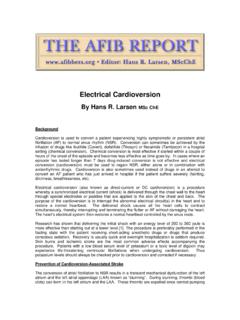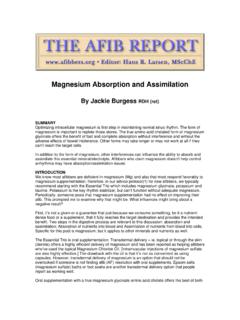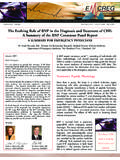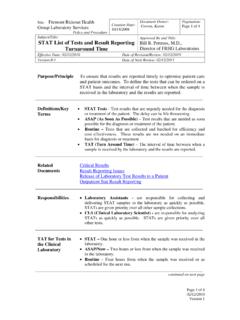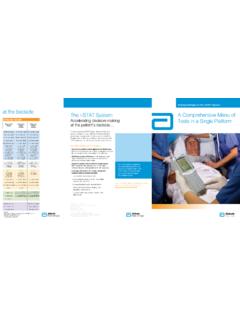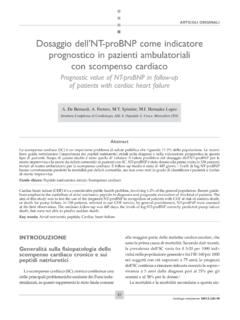Transcription of The Role of BNP in Atrial Fibrillation
1 The Role of BNP in Atrial Fibrillation By Hans R. Larsen MSc ChE. brain natriuretic peptide (BNP), a cousin of Atrial natriuretic peptide (ANP), is a hormone released from the walls of the ventricles when stretched such as during unusually strenuous activity. It is stored as a prohormone within secretory granules in the ventricles and is secreted as an N-terminal fragment, N- terminal pro- brain natriuretic peptide (nt-pro-BNP), and the smaller active hormone BNP. BNP has effects similar to those of ANP, that is, it decreases sodium reabsorption rate, renin release, and aldosterone release; it also increases vagal (parasympathetic) tone and decreases adrenergic (sympathetic) tone. Because nt-pro-BNP is easier to measure than BNP it is often used as a marker for BNP.
2 It is well established that BNP and nt-pro-BNP levels are elevated in heart failure and that the degree of elevation is directly proportional to the seriousness of the failure. However, researchers at the Massachusetts General Hospital have reported that lone afibbers also have elevated nt-pro-BNP values even when in sinus rhythm. Their study involved 150 participants with lone Atrial Fibrillation (LAF) and 75. afib-free controls matched according to age, gender, race, and ethnicity. The majority of participants (81%) were men, the average age at enrolment was 54 years, and the average age at first diagnosis was 45 years. The demographics of the study group thus closely mirrors that of the much larger groups involved in our own LAF surveys and, once again, puts paid to the still widely held notion that afib is solely a disease of old age, which it clearly is not.
3 At the time of enrolment 130 afibbers had the paroxysmal variety, while 20 were in permanent AF. Blood samples were obtained from all participants at enrolment. The researchers found that the median level of nt-pro-BNP was significantly higher among lone afibbers (even when in sinus rhythm) than among controls (166 versus 133 fmol/mL or 48 pg/mL versus 39 pg/mL); they also observed that nt-pro-BNP. levels were higher in afibbers with permanent LAF than in those with paroxysmal LAF (55 pg/mL versus 45 pg/mL), and that afibbers with high nt-pro-BNP levels at study entry were more likely to progress to the permanent version than were those with lower levels (57 pg/mL versus 47 pg/mL). There were no significant differences in ANP levels between afibbers and healthy controls, but ANP levels in afibbers who later developed hypertension were significantly higher than in those who did not (1090 versus 470.)
4 Pg/mL). The researchers speculate that BNP may be involved in sustaining fibrillatory rotors through its potentiating effect on vagal nerve impulses transmitted from the brain .[1]. BNP and Cardioversion Polish researchers investigated a group of afibbers with hypertension or coronary heart disease and found that BNP levels rise during an afib episode and tend to return to normal following a successful cardioversion. The decline in BNP level was quite significant with a drop from 95 to 28 pg/mL in paroxysmal afibbers and a drop from 75 to 41 pg/mL in persistent afibbers.[2]. In January 2010 Dr. Qi-xian Zeng and colleagues at the Shandong Communication Hospital in Jinan, China confirmed that patients with Atrial Fibrillation have elevated levels of both BNP and ANP when compared to healthy controls and that these levels decrease significantly after a successful cardioversion.
5 The study included 100 consecutive patients with paroxysmal or persistent AF and 20 healthy controls. About half the patients had coronary heart disease or hypertension, but none had heart failure. Prior to their scheduled cardioversion (chemical using amiodarone or propranolol) all patients had their blood levels of BNP and ANP measured. The cardioversion was initially successful in 60 patients, but 18. experienced recurrence within 24 hours and were, together with the 40 patients not successfully cardioverted, classified as permanent afibbers. Thus, 24 hours following the cardioversion 42 patients (42%) were in normal sinus rhythm (NSR), while 58 were still in afib. Both BNP and ANP levels decreased significantly immediately following the cardioversion with BNP levels dropping from an average of 162 pg/mL to 124 pg/mL and ANP levels declining from 200 pg/mL to 164 pg/mL.
6 Both BNP and ANP levels were significantly higher in the 16. patients who relapsed into AF within 24 hours of being cardioverted than among those who remained in NSR (BNP of 180 versus 132 pg/mL and ANP of 188 versus 138 pg/mL). The 42 patients still in NSR after 24 hours were followed for an additional 500 days. At the end of this period, 26 were still in NSR corresponding to an overall 500-day success rate of 26% for the 100 patients originally undergoing cardioversion. The average baseline BNP value for those who remained in NSR for 500 days was 122 pg/mL as compared to 147 pg/mL for the patients who relapsed during the 500 days. Corresponding numbers for ANP were 129 and 153 pg/mL. In comparison, BNP and ANP values for healthy controls were 81 and 100 pg/mL respectively.
7 The Chinese researchers conclude that baseline BNP and ANP levels can be used to predict the likely outcome of cardioversion and that afibbers with a BNP level of less than 138 pg/mL have a good chance of being successfully converted.[3]. In contrast to the findings of the Chinese researchers, Polish researchers recently reported that, while baseline ANP levels are substantially higher among persistent afibbers than among healthy controls, there was no correlation between the maintenance of sinus rhythm during 30 days after electrical cardioversion and baseline ANP level. They did confirm that ANP levels decreased significantly after a successful cardioversion.[4]. Thus, it would appear that, while a low baseline BNP is likely associated with better cardioversion outcome, a similar correlation with ANP is in doubt.
8 BNP and Catheter Ablation Japanese researchers conducted a study involving 66 (54 men) paroxysmal afibbers with no underlying heart disease (lone afibbers). The average age of the study participants was 61 years (range of 51-71. years); they had suffered from afib for 1-7 years, had failed 2-4 class I or class II antiarrhythmic drugs, and experienced episodes that self-converted in less than 24 hours. Their average left Atrial diameter was 35 mm (range of 25-45 mm). The participants all underwent a segmental, ostial PVI targeting all 4 pulmonary veins and were followed up for 3 months after their last ablation. The follow-up included monthly 24-hour Holter recordings and ANP and BNP determination at baseline and 3 months.
9 Three months after the initial PVI, only 53% of the study participants were still in normal sinus rhythm without the use of antiarrhythmic drugs. Nine (14%) of the unsuccessfully ablated patients underwent second and third procedures. Five became afib- free after the second procedure, and two achieved continuous normal sinus rhythm (NSR) after the third procedure. The Japanese researchers made the following observations: At baseline, both ANP and BNP levels were elevated in 14 patients (21%) and in the remaining 52 patients (79%) only BNP level was elevated. There were no significant correlations between episode frequency and duration and ANP/BNP levels or left ventricular (LV) ejection fraction. There was a significant, but weak correlation between ANP and BNP levels and afib burden (episode frequency x duration) prior to the PVI.
10 BNP level was positively correlated with left Atrial dimension. Patients with elevated ANP levels tended to experience more episodes and a higher afib burden than those with normal levels. Both ANP and BNP levels decreased significantly after the first PVI whether ultimately successful or not (ANP from an average of 69 to 25 pg/mL and BNP from 58 to 23 pg/mL). In patients with elevated ANP only (at baseline) the ANP concentration returned to normal after the initial PVI. Average BNP levels decreased from to pg/mL in the 35 patients whose first PVI. was successful. An enlarged left atrium at baseline was associated with a greater chance of the PVI being unsuccessful. No association was observed between ANP/BNP level at baseline and the outcome of the PVI.
